A Hybrid Lifetime Extended Directional Approach for WBANs
Abstract
:1. Introduction
- (1)
- Directional antenna technology is employed in LEDA MAC for sensor nodes in different sectors. The LEDA MAC switches between multi-beam and single-beam directional mode for data reservation and transmission. The proposed single-beam transmission mode enjoys features of simplicity in system configuration, low complexity in data processing. What is more, the adaptive design in LEDA MAC avoids the impacts of deafness and hidden terminal problem, decreases the energy waste and thus extends the network lifetime.
- (2)
- The hybrid MAC combines the strength of contended and scheduled mechanism. Data request frames for reservation access the channel in contention-based mechanism and packet transmissions are in scheduled mechanism, achieving high link utilization and low packet delay in unsaturated network and reducing collision probability in saturated network. Both the data reservation and transmission are according to the User Priorities (UP), ensuring the privilege of emergency data.
- (3)
- Considering burst data, a modified adaptive superframe is proposed. A dynamic polled allocation period is designed to guarantee the on-demand and emergency data transmissions. The specific fields of frame control frame for polled allocation are supplied, which facilitates the study for other researchers.
2. Related Work
2.1. Previous Work
2.2. Preliminary Study
2.2.1. Directional Antennas
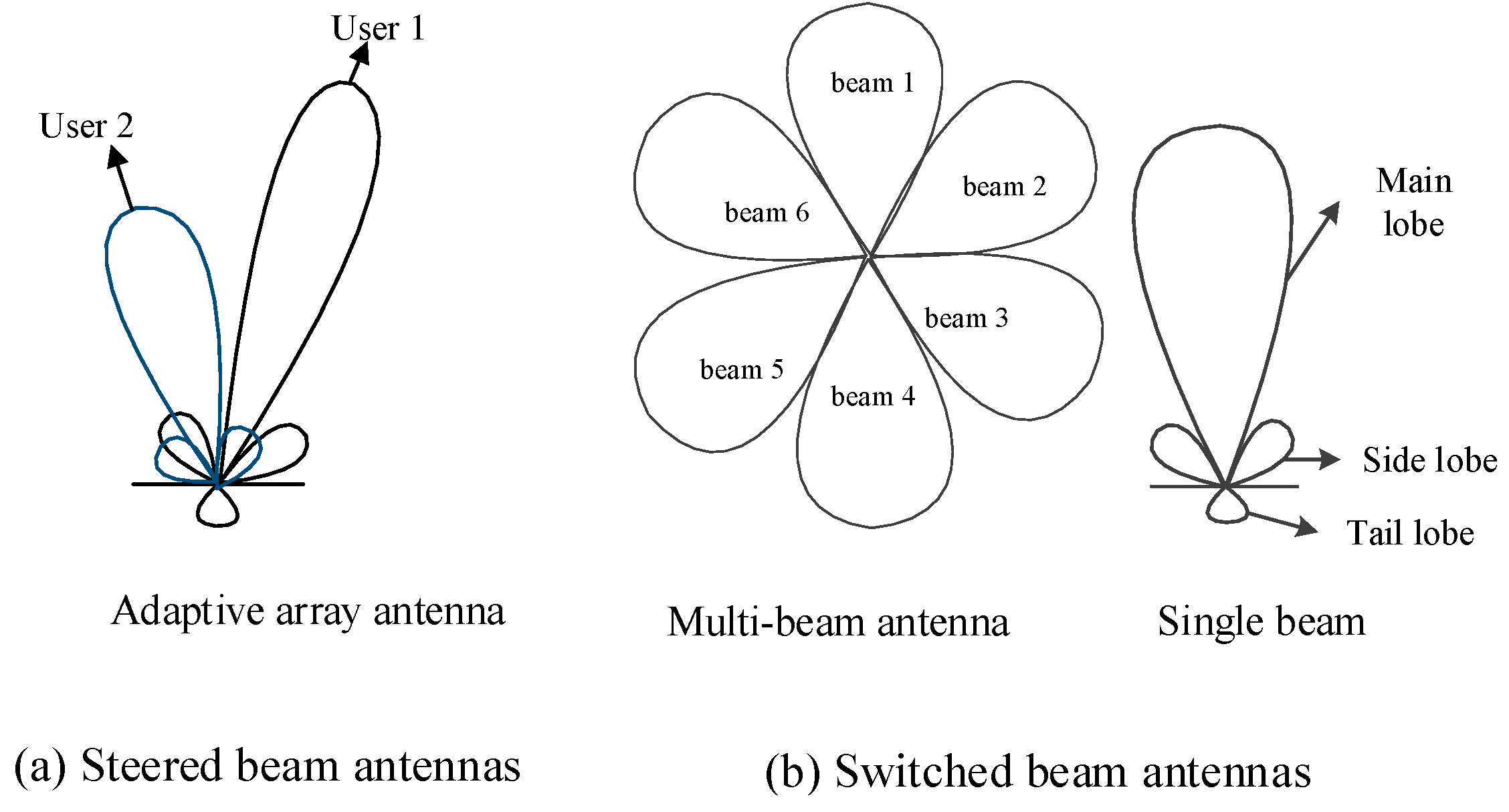
2.3. IEEE 802.15.6

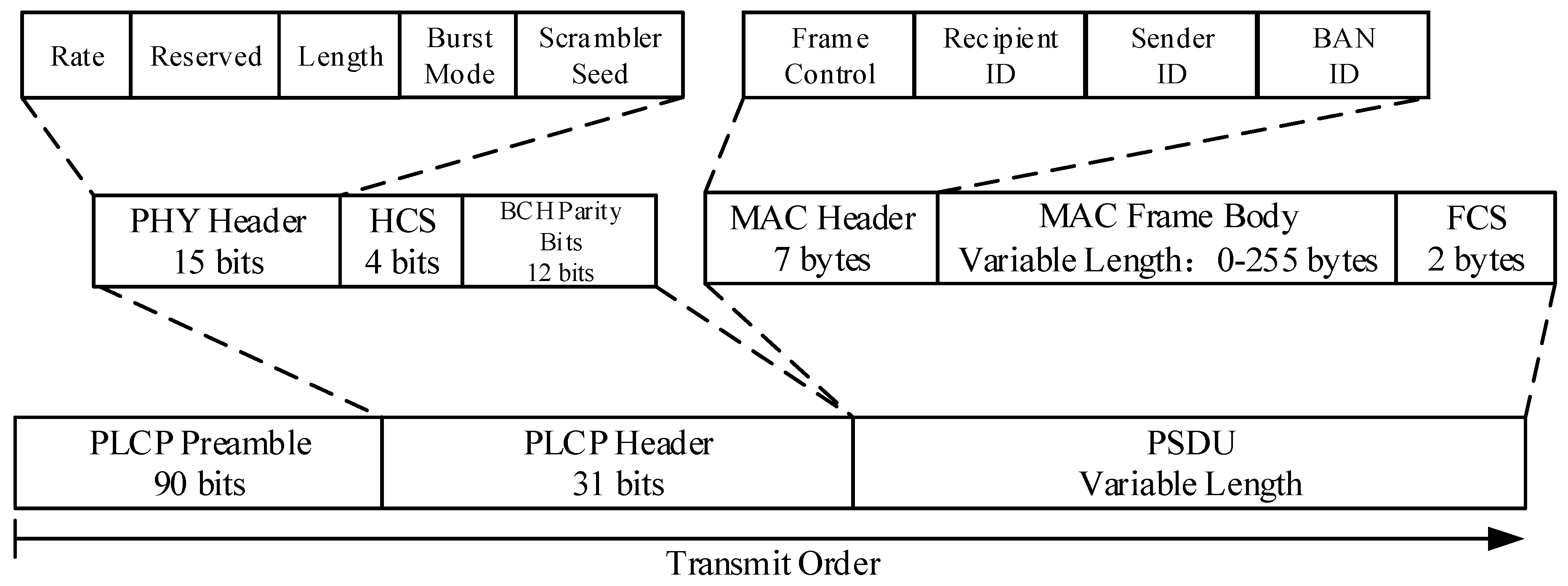
3. The Proposed MAC Protocol
3.1. System Model
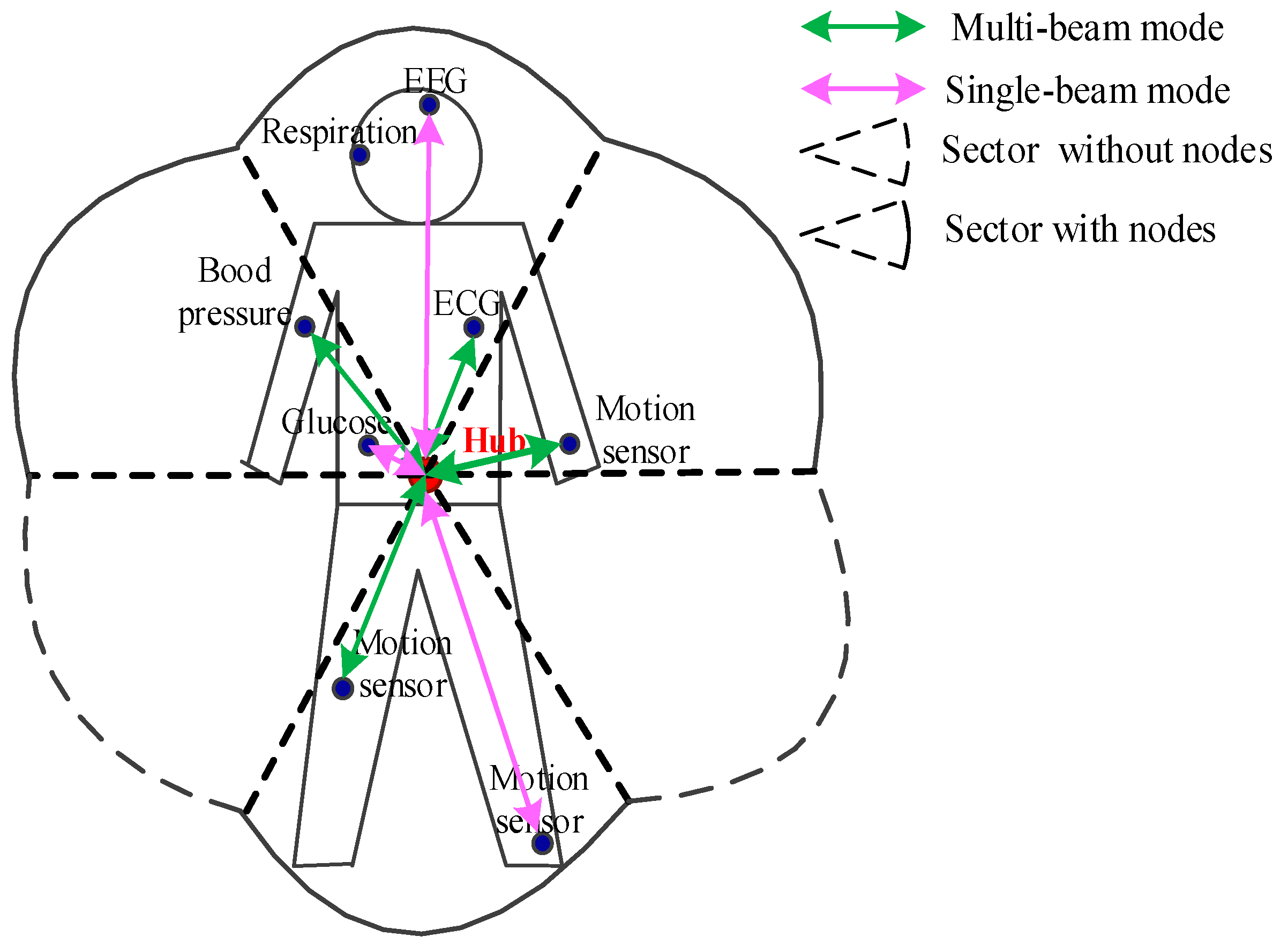
3.2. LEDA MAC Protocol
3.2.1. Superframe of LEDA MAC Protocol
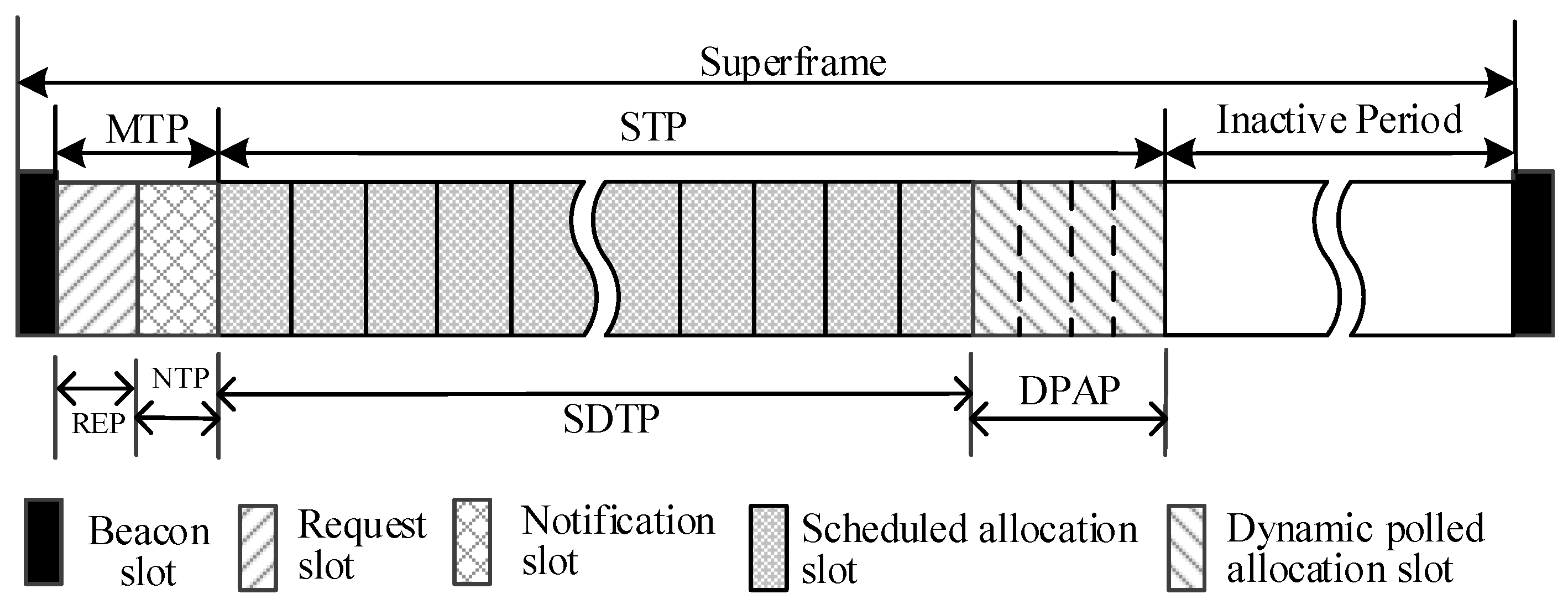
- (1)
- Multi-Beam Transmission Period (MTP): All nodes work in multi-beam antenna mode at the start of a superframe. Simultaneous transmissions are permitted in multi-beam mode. The specific function of each phase in MTP is introduced in the following subsections.
- (a)
- Beacon: The beacon frame is transmitted by the hub at the start of each superframe to notify the network management of information, such as power management of the nodes in the WBAN, and to facilitate clock synchronization therein. All the nodes, the beams of which point to hub, can be informed.
- (b)
- Request Period (REP): Only Data Request Frames (DRFs) instead of data frames could be sent in REP in multi-beam mode. Data request frame always includes the user priority, the length of data packet, the location of nodes and any other information, as depicted in Figure 6. DRFs access the channel in CSMA/CA mechanism for slots reservation. The collision probability can be smaller because the request frame is generally short.Figure 6. The Data request frame format.
- (c)
- Notification Period (NTP): Hub broadcasts Notification Frames (NTFs) in NTP to notify the assignment information. The related information about transmission order and the number of time slots needed to send data in NTFs are appointed by the hub according to the information included in the DRFs gathered in REP. A user with higher UP can be assigned slots preferentially. Prioritized access of differing UPs shall be attained through the predefined relationship in Table 1.
Table 1. User priorities mapping. Priority User Priority(UP) Traffic Designation Frame Type Lowest 0 Background (BK) Data 1 Best effort (BE) Data 2 Excellent effort (EE) Data 3 Video (VI) Data 4 Voice (VO) Data or management 5 Medical data or network control Data or management 6 High priority medical data or network control Data or management Highest 7 Emergency or medical implanted event report Data - (2)
- Single-Beam Transmission Period (STP): In LEDA MAC protocol, STP is divided into two parts: single-beam data transmission period and dynamic polled access period.
- (a)
- Single-Beam Data Transmission Period (SDTP): In SDTP, hub directionally interacts with nodes in each sector according to the notification packets. Any data transmissions out of node’s allocated slots will not be initiated. The data interaction in STP is generated in an active beam, which can reduce the interference of neighbor nodes. The nodes with no data transmission will turn into inactive state to save energy.
- (b)
- Dynamic Polled Allocation Period (DPAP): Burst traffic may emerge before the last frame transaction. If slots have not been reserved for burst data, the data will have to wait until the next superframe to be transmitted, which will lead high packet delay. To solve this problem, dynamic polled allocation period is designed in STP. Hub will send control type frame I-ACK+Poll to provide polled allocation. The fields of the MAC header are listed below in Figure 7.

- (3)
- Inactive Period: Inactive state is an internal power management state that is not ready for frame transmission and reception. A node can turn to inactive state, i.e., sleep mode over some time intervals in a superframe to save energy, if it does not need to transmit a management or data type frame in the corresponding access phase. An illustrating example is shown in Figure 8. Nodes can be in sleep mode during beacon transmission time, RAP and MAP. A node is in inactive state during its scheduled allocation intervals and polled allocation intervals on determining that the remaining interval has been relinquished by itself or reclaimed by its hub due to no more pending transmissions. If there is heavy traffic for nodes to transmit in the network, they will be definitely busy throughout the superframe without inactive state.

3.2.2. Transmission Progress Description



3.3. Deafness and Hidden Terminal Problem Avoidance
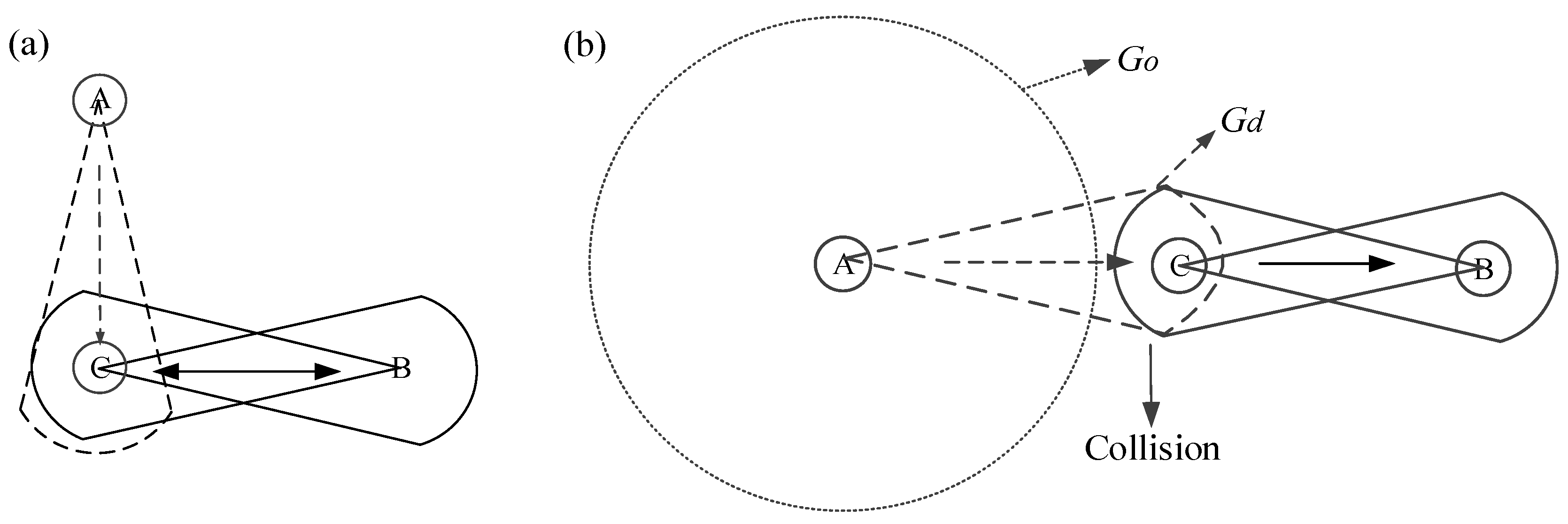
4. Theoretical Analysis
4.1. Throughput
4.2. Delay
4.3. Energy Consumption
4.4. Network Lifetime
5. Simulation Results
| Parameters | Value | Parameters | Value |
|---|---|---|---|
| Information rate | 971.4 kbps | Beacon | 15 bytes |
| Superframe length | 1 s | PLCP preamble | 90 bits |
| Slot length | 5 ms | PLCP header | 31bits |
| Transmit power | −3 dBm | MAC header | 7 bytes |
| Received power | 0 dBm | Wakeup | 8 bytes |
| Directional transmit power | −25 dBm | MAC ACK size | 9 bytes |
| Directional received power | −22 dBm | Payload | 255 bytes |
| Inactive power | 4 μw | Buffer size | 20,000 bytes |
| Turnaround time | 75 μs | Simulation time | 30 s |
| pSIFS | 75 μw | Frequency band | 2400–2438.5 MHz |

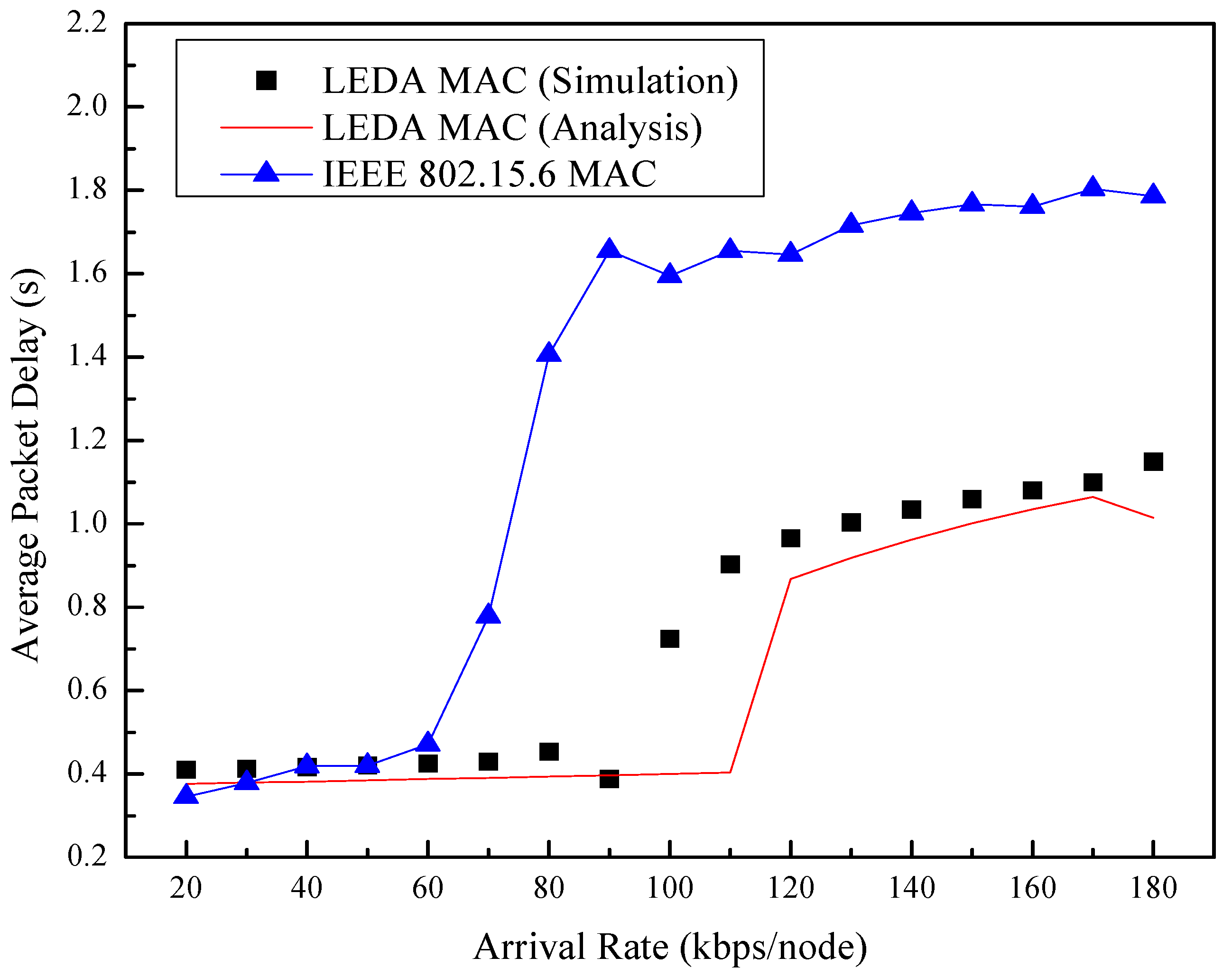

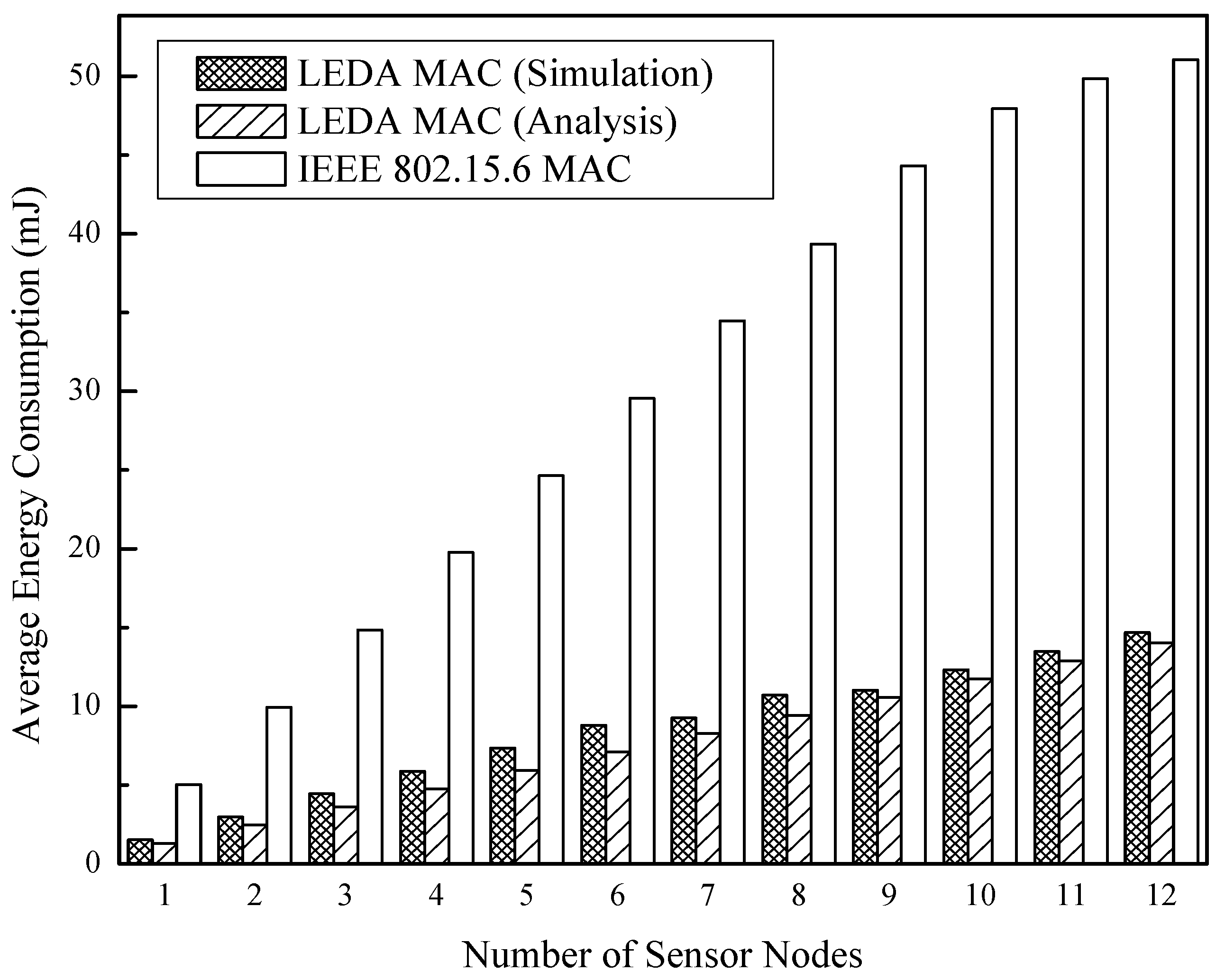
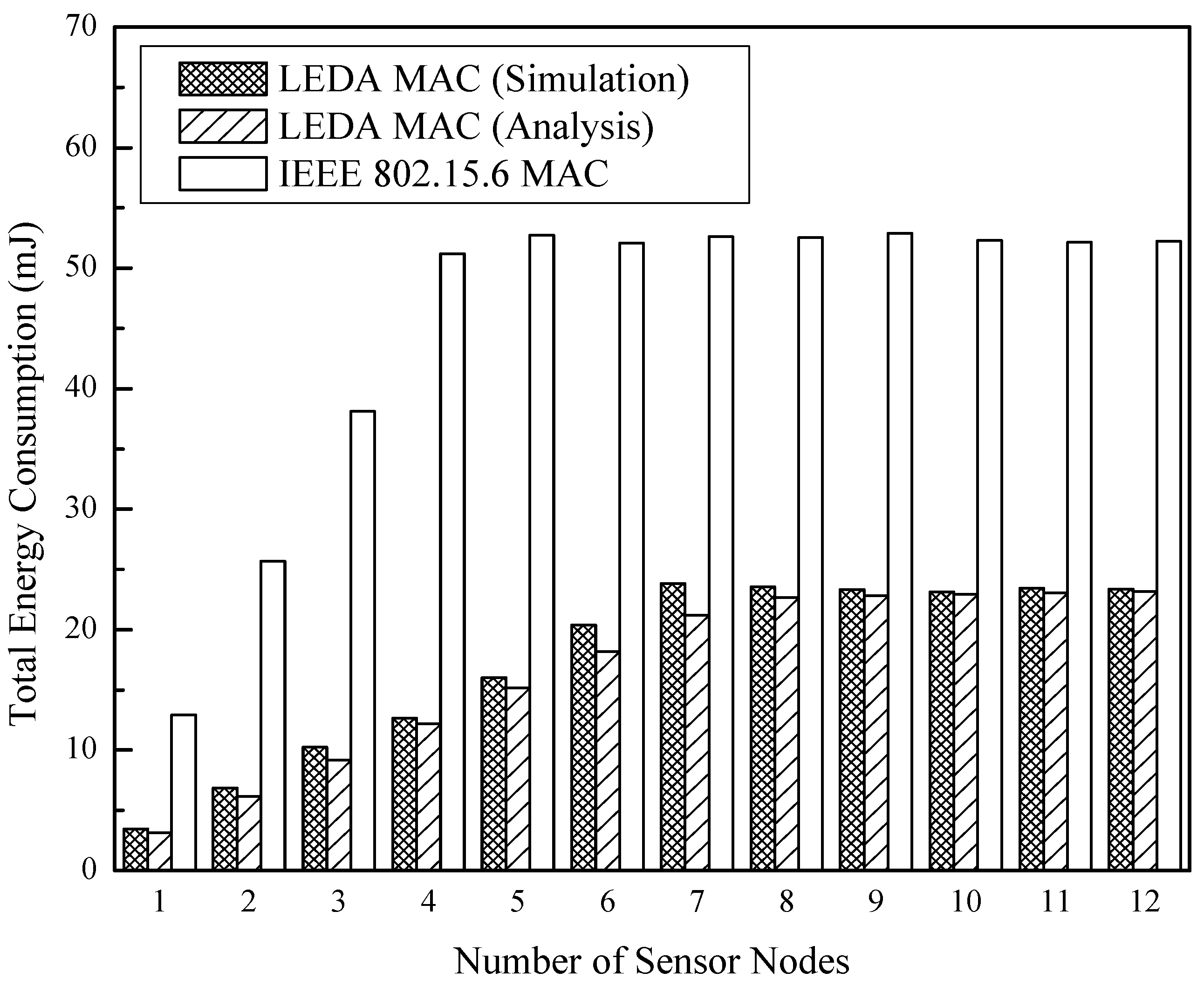
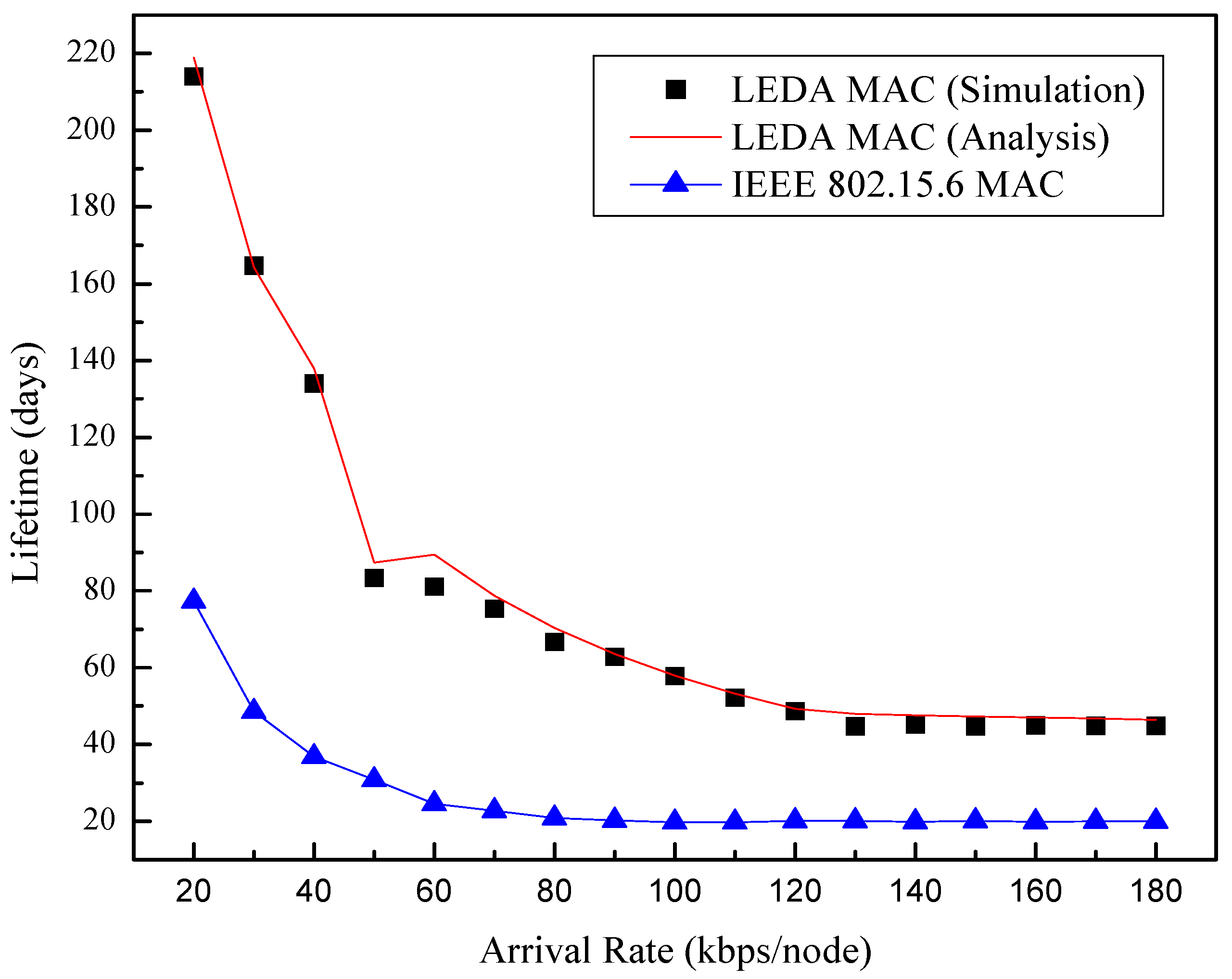
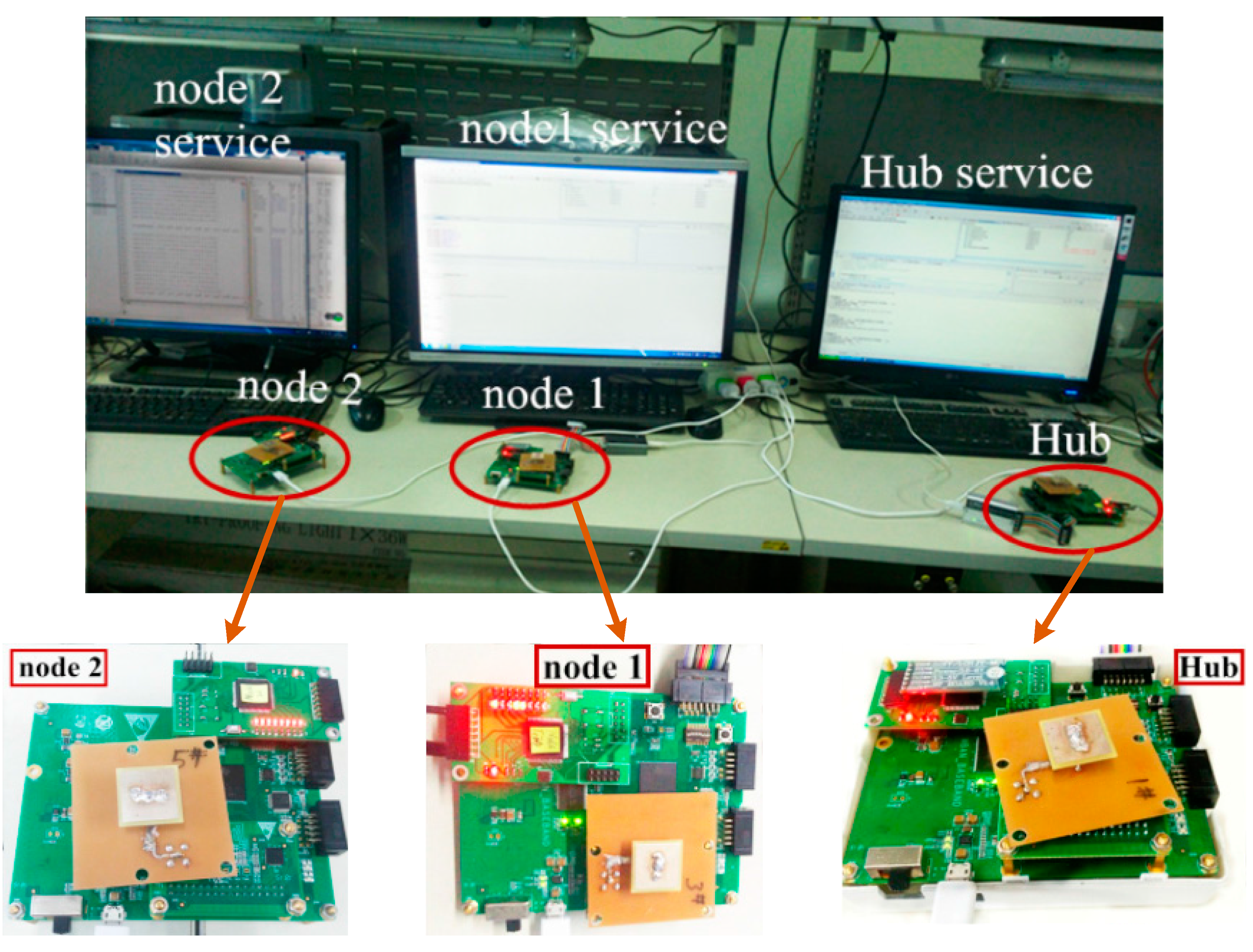
6. Conclusions
Acknowledgments
Author Contributions
Conflicts of Interest
References and Notes
- Cao, H.; Leung, V.; Chow, C.; Chan, H. Enabling technologies for wireless body area networks: A survey and outlook. IEEE Commun. Mag. 2009, 47, 84–93. [Google Scholar] [CrossRef]
- Kartsakli, E.; Lalos, A.S.; Antonopoulos, A.; Tennina, S.; Renzo, M.D.; Alonso, L.; Verikoukis, C. A survey on M2M systems for mhealth: A wireless communications perspective. Sensors 2014, 14, 18009–18052. [Google Scholar] [PubMed]
- Cavallari, R.; Martelli, F.; Rosini, R.; Buratti, C.; Verdone, R. A survey on wireless body area networks: technologies and design challenges. IEEE Commun. Surv. Tutor. 2014, 16, 1635–1657. [Google Scholar] [CrossRef]
- Latre, B.; Braem, B.; Blondia, C.; Moerman, I.; Demeester, P. A survey on wireless body area networks. Wirel. Netw. 2011, 17, 1–18. [Google Scholar] [CrossRef]
- Boulis, A.; Smith, D.; Miniutti, D.; Libman, L. Challenges in body area networks for healthcare: the MAC. IEEE Commun. Mag. 2012, 50, 100–106. [Google Scholar] [CrossRef]
- Ha, I. Technologies and research trends in wireless body area networks for healthcare: A systematic literature review. Int. J. Distrib. Sens. Netw. 2015, 2015, 1–14. [Google Scholar]
- Choudhury, R.R.; Yang, X.; Ramanathan, R.; Vaidya, N.H. On designing MAC protocols for wireless networks using directional antennas. IEEE Trans. Mob. Comput. 2006, 5, 477–491. [Google Scholar] [CrossRef]
- Bazan, O.; Jaseemuddin, M. A survey on MAC protocols for wireless ad hoc networks with beamforming antennas. IEEE Commun. Surv. Tutor. 2012, 14, 216–239. [Google Scholar] [CrossRef]
- IEEE 802.15.6 standard for local and metropolitan area networks—Part15.6: Wireless body area networks. IEEE Std. 802.15.6 2012. [CrossRef]
- Choudhury, R.; Vaidya, N. Deafness: A MAC problem in ad hoc networks when using directional antennas. In Proceedings of the 12th IEEE International Conference on Network Protocols (ICNP), Berlin, Germany, 5–8 October 2004; pp. 283–292.
- Subramanian, A.P.; Das, S.R. Addressing deafness and hidden terminal problem in directional antenna based wireless multi-hop networks. Wirel. Netw. 2010, 16, 1557–1567. [Google Scholar] [CrossRef]
- Ullah, S.; Shen, B.; Islam, S.M.R.; Khan, P.; Saleem, S.; Kwak, K.S. A study of MAC protocols for WBANs. Sensors 2010, 10, 128–145. [Google Scholar] [CrossRef] [PubMed]
- Wei, Y.; Heidemann, J.; Estrin, D. An energy-efficient MAC protocol for wireless sensor networks. In Proceedings of the IEEE Computer and Communications Societies, New York, NY, USA, 23–27 June 2002; pp. 1567–1576.
- Van, D.T.; Langendoen, K. An adaptive energy-efficient MAC protocol for wireless sensor networks. In Proceedings of the 1st International Conference on Embedded Networked Sensor Systems, Los Angeles, CA, USA, 5–7 November 2003; pp. 171–180.
- Ullah, S.; Chen, M.; Kwak, K.S. Throughput and delay analysis of IEEE 802.15.6-based CSMA/CA protocol. J. Med. Syst. 2012, 36, 3875–3891. [Google Scholar] [CrossRef] [PubMed]
- Rashwand, S.; Misic, J.; Misic, V.B. Analysis of CSMA/CA mechanism of IEEE 802.15.6 under non-saturation regime. IEEE Trans. Parall. Distr. 2015. [Google Scholar] [CrossRef]
- Rashwand, S.; Misic, J.; Khazaei, H. IEEE 802.15.6 under saturation: some problems to be expected. J. Commun. Netw. 2011, 13, 142–148. [Google Scholar] [CrossRef]
- Rashwand, S.; Misic, J. Effects of access phases lengths on performance of IEEE 802.15.6 CSMA/CA. Comput. Netw. 2012, 56, 2832–2846. [Google Scholar] [CrossRef]
- Esteves, V.; Antonopoulos, A.; Kartsakli, E.; Puig-Vidal, M.; Miribel-Català, P.; Verikoukis, C. Cooperative energy harvesting-adaptive MAC protocol for WBANs. Sensors 2015, 15, 12635–12650. [Google Scholar] [CrossRef] [PubMed] [Green Version]
- Marinkovic, S.J.; Popovici, E.M. Energy-efficient low duty cycle MAC protocol for wireless body area networks. IEEE Trans. Inf. Technol. Biomed. 2009, 13, 915–925. [Google Scholar] [CrossRef] [PubMed]
- Tachtatzis, C.; Franco, F.D.; Tracey, D.C.; Timmons, N.F.; Morrison, J. An energy analysis of IEEE 802.15.6 scheduled access modes. In Proceedings of the IEEE GLOBECOM Workshops (GC Wkshps), Miami, FL, USA, 6–10 December 2010; pp. 1270–1275.
- Tiwary, P.K.; Baek, W.S.; Kim, D.M.; Pyun, J.Y. A study on ultra low power MAC protocols over Wireless Body Area Network. In Proceedings of the TENCON 2012—2012 IEEE Region 10 Conference, Cebu, Philippines, 19–22 November 2012; pp. 1–6.
- Ullah, S.; Kwak, K.S. An ultra low-power and traffic-adaptive medium access control protocol for wireless body area network. J. Med. Syst. 2012, 36, 1021–1030. [Google Scholar] [CrossRef] [PubMed]
- Ullah, N.; Khan, P.; Kwak, K. A very low power MAC (VLPM) protocol for wireless body area networks. Sensors 2011, 11, 3717–3737. [Google Scholar] [CrossRef] [PubMed]
- Omeni, O.; Wong, A.C.W.; Burdett, A.J.; Toumazou, C. Energy efficient medium access protocol for wireless medical body area sensor networks. IEEE Trans. Biomed. Circ. Syst. 2008, 2, 251–259. [Google Scholar] [CrossRef] [PubMed]
- Su, H.; Zhang, X. Battery-dynamics driven TDMA MAC protocols for wireless body-area monitoring networks in healthcare applications. IEEE J. Sel. Areas Commun. (JSAC) 2009, 27, 424–434. [Google Scholar] [CrossRef]
- Nie, Z.; Li, Z.; Huang, R.; Liu, Y.; Li, J.; Wang, L. A statistical frame based TDMA protocol for human body communication. Biomed. Eng. Online 2015, 14. [Google Scholar] [CrossRef] [PubMed]
- Rhee, I.; Warrier, A.; Aia, M.; Min, J. Z-MAC: A hybrid MAC for wireless sensor networks. IEEE/ACM Trans. Netw. 2005, 16, 90–101. [Google Scholar]
- Gama, O.; Simoes, R. A hybrid mac scheme to improve the transmission performance in body sensor networks. Wirel. Pers. Commun. 2015, 80, 1263–1279. [Google Scholar] [CrossRef]
- Fang, G.; Dutkiewicz, E. BodyMAC: Energy efficient TDMA-based MAC protocol for wireless body area networks. In Proceedings of the International Symposium on Communications and Information Technologies 2009 (ISCIT 2009), Incheon, Korea, 28–30 September 2009; pp. 1455–1459.
- Ibarra, E.; Antonopoulos, A.; Kartsakli, E.; Verikoukis, C. HEH-BMAC: Hybrid polling MAC protocol for wireless body area networks operated by human energy harvesting. Springer Telecommun. Syst. J. 2014, 58, 111–124. [Google Scholar]
- Pourmohseni, B.; Eshghi, M. Reliable energy-efficient dynamic TDMA MAC protocol for wireless body area networks. Int. J. Appl. Innov. Eng. Manag. (IJAIEM) 2013, 2, 393–402. [Google Scholar]
- Li, C.; Hao, B.; Zhang, K.; Liu, Y.; Li, J. A novel medium access control protocol with low delay and traffic adaptivity for wireless body area networks. J. Med. Syst. 2011, 35, 1265–1275. [Google Scholar] [CrossRef] [PubMed]
- Ibarra, E.; Antonopoulos, A.; Kartsakli, E.; Rodrigues, J.; Verikoukis, C. QoS-aware energy management in body sensor nodes powered by human energy harvesting. IEEE Sens. J. 2015. [Google Scholar] [CrossRef]
- Kang, C.; Wu, S.; Tarng, J. A novel folded UWB antenna for wireless body area network. IEEE Trans. Antennas Propag. 2012, 60, 1139–1142. [Google Scholar] [CrossRef]
- Haga, N.; Saito, K.; Takahashi, M.; Ito, K. Characteristics of cavity slot antenna for body-area networks. IEEE Trans. Antennas Propag. 2009, 57, 837–843. [Google Scholar] [CrossRef]
- Klemm, M.; Kovcs, I.Z.; Pedersen, G.F.; Troster, G. Novel small-size directional antenna for UW-B WBAN/WPAN applications. IEEE Trans. Antennas Propag. 2005, 53, 3884–3896. [Google Scholar] [CrossRef]
- Mijovica, S.; Burattia, C.; Zanellab, A.; Verdone, R. A cooperative beamforming technique for body area networks. Proced. Comput. Sci. 2014, 40, 181–189. [Google Scholar] [CrossRef]
- Hussain, M.A.; Alam, N.; Ullah, S.; Ullah, N.; Kwak, K.S. TDMA based directional MAC for WBAN. In Proceedings of the 6th International Conference on Networked Computing, Gyeongju, Korea, 11–13 May 2010; pp. 1–5.
- Hussain, M.A.; Alam, N.; Kwak, K.S. Directional MAC approach for wireless body area networks. Sensors 2011, 11, 771–784. [Google Scholar] [CrossRef] [PubMed]
- Yuan, X.; Li, C.; Song, Y.; Yang, L.; Ullah, S. On energy-saving in e-healthcare: a directional MAC protocol for WBAN. In Proceedings of the IEEE GLOBECOM Workshops (GC Wkshps), San Diego, CA, USA, 6–10 December 2015.
- Friis, H.T. A note on a simple transmission formula. Proc. IRE 1946, 34, 254–256. [Google Scholar] [CrossRef]
- Reusens, E.; Joseph, W.; Latre, B.; Braem, B.; Vermeeren, G.; Tanghe, E.; Martens, L.; Moerman, I.; Blondia, C. Characterization of on-body communication channel and energy efficient topology design for wireless body area networks. IEEE Trans. Inf. Technol. Biomed. 2009, 13, 933–945. [Google Scholar] [CrossRef] [PubMed]
- Ryckaert, J.; de Doncker, P.; Meys, R.; de le Hoye, A.; Donnay, S. Channel model for wireless communication around human body. Electron. Lett. 2004, 40, 543–544. [Google Scholar] [CrossRef]
- Datasheet, T. CC2420: 2.4GHz IEEE 802.15.4/ZigBee-Ready RF Transceiver. Chipcon Products from Texas Instruments. Available online: http://focus.ti.com/lit/ds/symlink/cc2420.pdf (accessed on 15 October 2015).
© 2015 by the authors; licensee MDPI, Basel, Switzerland. This article is an open access article distributed under the terms and conditions of the Creative Commons Attribution license (http://creativecommons.org/licenses/by/4.0/).
Share and Cite
Li, C.; Yuan, X.; Yang, L.; Song, Y. A Hybrid Lifetime Extended Directional Approach for WBANs. Sensors 2015, 15, 28005-28030. https://doi.org/10.3390/s151128005
Li C, Yuan X, Yang L, Song Y. A Hybrid Lifetime Extended Directional Approach for WBANs. Sensors. 2015; 15(11):28005-28030. https://doi.org/10.3390/s151128005
Chicago/Turabian StyleLi, Changle, Xiaoming Yuan, Li Yang, and Yueyang Song. 2015. "A Hybrid Lifetime Extended Directional Approach for WBANs" Sensors 15, no. 11: 28005-28030. https://doi.org/10.3390/s151128005






